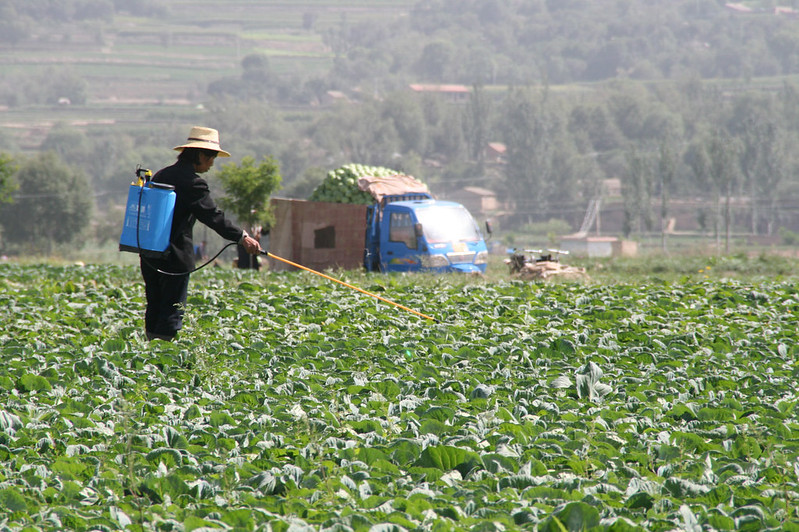Have you ever asked how to calculate the correct amount of pesticide? Using the optimum quantity of pesticide and fertilizer reduces the possibility of human, commercial, or environmental harm.
You may use the information in this article to make pesticide and lawn, and garden fertilizer choices and calculate dosage rates.

What Is A Pesticide?
Pesticides are chemical substances used to kill, repel, attract, or control pests. Pesticide gets its suffix from the Latin root, which means “to kill.”
Mosquitoes, ticks, rats, and mice are among the pests and disease carriers that pesticides suppress. In agriculture, pesticides manage weeds, insect infestations, and illnesses.
However, given the preceding criteria, not all pesticides kill. Take insect repellents, for example, which are subject to the same stringent regulations as all other pesticides.
The insecticide, weed killer, or fungicide are typical pesticides readily available in stores.
Using pesticides is common among growers, homeowners, and companies alike to keep illness at bay and crops from being destroyed. Pesticides are essential in the agricultural kit to protect the world’s food supply against insects, conditions, and alien plants.
Chemical pesticides serve to keep food supplies safe and affordable for customers while also ensuring the high quality of their food.
Other than that, people and their property can also benefit from pesticides. As a result of pesticides, termites, rodents, and other filthy pests, it can keep at bay.
The West Nile virus, Lyme disease, and malaria may all get transmitted by mosquito bites; thus, people use pesticides in the form of bug repellant to protect themselves and their families.
It is also an additional tool for keeping gardens free of pesky insects and invasive plants.
What Are The Benefits Of Using Pesticides?
The significant advantages of pesticide use are the immediate results of their actions — the anticipated benefits. Some of them are more subtle, less visible, or long-term.
In addition to boosting food output, pesticides can also help farmers generate more revenue.
Pesticides have made it feasible to control pests and produce more food, allowing us to eat more. Farmers may boost their bottom lines by growing more crops and selling the extra produce they generate.
People employ pesticides in a wide range of applications, agriculture being one of the most critical. A more significant amount of food can be grown on the same land.
Depending on crop type, pest and disease losses might range from 30 to 50 percent. Pesticides help food security by safeguarding crops and ensuring a steady supply of high-quality and inexpensive food.
How To Calculate The Right Amount Of Pesticide
Regardless of the equipment or pesticide used, the three processes for equipment calibration are the same. First, choose the right pesticide and application equipment; second is to determine how big the treatment area is; and third is to determine how much you’ll need.
Step #1. You’ll need to figure out how much area needs to be treated. Lawn products typically use rate reports of about 1000 square feet or acre.
Flowers, shrubs, and vegetables have a price per 100 square feet. To figure out how much pesticide or fertilizer you’ll need for a project, first measure the size of the area that has to be treated.
Likely, you won’t be treating a “geometrically ideal” area. To make total area calculations easier, irregularly shaped flower beds divide into smaller geometric areas (square, rectangle, circle, triangle).
Multiply the size of each shape by the number of forms.
Step #2. Read the product label for specific instructions on the amount to mix. In contrast, it may be necessary to calculate the total square footage of structures within the area such as buildings, patios, sidewalks, ponds, and so on — and subtract it from the overall size.
Step #3. To make this solution, convert the percentage of concentrate in the final answer to a decimal before determining the concentration amount to mix with water. To convert rates to decimals, multiply the percentage by 100 to obtain the decimal.
We are shifting the decimal point two positions to the left and adding zeros when necessary.
Pesticides are not offered in their purest form since they are extremely dangerous. To avoid the risk of poisoning the applicator or a human being, they dilute with any carrier.
Only analytical and toxicological research uses pure forms of technical grades. Pesticides are in concentrates, water-dispersible powders, dust, granules, solutions, and other formulations (by adding various ingredients).
The label specifies the strength or active component. When using herbicides to manage pests, you must apply them correctly.
To get the best results, follow the instructions on the container label. Applying the required quantity is the applicator’s responsibility.
You may check this link to learn more about doing pesticide calculations.
Conclusion
We hope that we have reached your satisfaction with the provided information on how to calculate the correct amount of pesticide. You can check these links as guides on how to calculate liquid fertilizer rates and how does pest control work.
